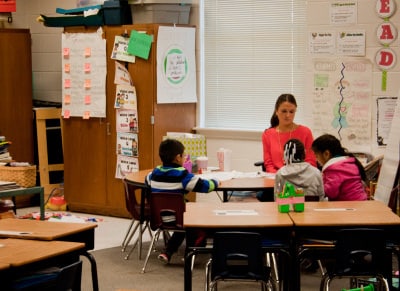
2016 House Bill 1030, Section 8.33 will be harmful to public education in North Carolina, to a lesser or greater extent depending on which local school district the students attend, and with differing impacts statewide depending on a variety of other factors. This section of last year’s Budget Bill requires that school districts have average class sizes equal to or less than the state-allotted ratios of teachers to students in grades K-3.
Currently, those ratios are one teacher per 18 students in kindergarten, per 16 students in first grade, and per 17 students in second and third grades. The difficulty for many North Carolina school districts is that currently, those same allotments of teachers have to be used also to fund supplemental elementary art, music, and physical education teachers that will not be able to be counted toward the class size averages under the new legislation. Additionally, students almost never show up at a given school in neat groupings of 18, 16, or 17 per grade level. A school with 40 kindergartners would qualify for 2.22 state-allotted teachers but would have to have 3 teachers and classrooms to keep average class sizes at or below 18. And finally, many school districts do not have enough classroom space to open the additional classrooms required by the legislation.
Some of the other problems most school districts face in complying with the legislation include:
- Most will not be able to fill all of the required K-3 classroom teacher positions with qualified teachers. The dwindling supply of qualified K-3 teachers will go to Raleigh, or Charlotte, or Chapel Hill, or Houston, or wherever they can earn a higher starting salary than 95 percent of North Carolina school districts pay. Mandatory lower class sizes likely will lower the overall quality of instruction rather than improve it for this and for the following reasons.
- Music, art, and physical education (PE) teachers will be lost. I hope everybody read the article in the Monday, January 23rd edition of the Winston-Salem Journal about the Greenville teacher who helped his economically disadvantaged students be successful on the accountability tests through the use of music. He was recognized on national TV for his creative and effective integration of music into his instructional lessons. Some students learn through music. Some students learn through expression (arts). And some students learn through physical activities. All of those students will suffer when school districts have to convert music, art, and PE teacher positions to regular K-3 teacher positions.
- With the loss of music, art, and PE teachers, regular K-5 teachers will lose their daily planning time provided by pulling out students to go to this supplemental instruction. If you have ever tried to teach young children three or four different subjects for 6.5 hours in a day, you recognize that 20-30 minutes of daily planning time is not a luxury, but an absolute necessity if you are going to move seamlessly through the lessons for that extended period of time. Daily instruction will suffer and teachers will burn out more quickly than ever before.
- School districts will be evaluating all other possible strategies to help offset some of these problems, especially those with limited or no additional classroom space. One of those strategies almost encouraged by the new legislation is to increase class sizes in grades 4-5, where the legislation grants “maximum flexibility” with class sizes. Elementary teachers are licensed to teach K-6, so movement of teachers among grade levels happens some now. Increasing class sizes in grades 4-5 could provide some of the necessary additional teachers for grades K-3 and free up some of the classroom space needed. Would it be instructionally sound to have grades 4-5 classrooms with, say, 30 students each? Probably not without some additional investments in tools, training, or other supports for those teachers. Some school districts, however, might not have any other viable choice.
This legislation has put most North Carolina school district leaders between a rock and a hard place. They would all love to have class sizes in the range of 16-18 students in K-3, but they recognize all of the above problems and potential harmful effects of it being mandated with no additional resources or flexibility. The bottom line is that every North Carolina school district is unique and needs some flexibility in organizing their K-3 classes. House Bill 13 introduced in the 2016 Fourth Extra Session to grant average K-3 class size maximums at a +3 “cushion” above the state-allotted ratios is an excellent and needed compromise.
Recommended reading



